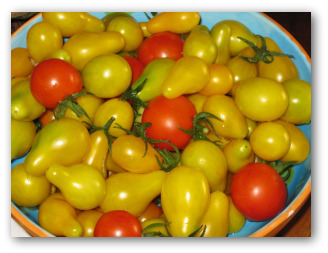Tips for Fertilizing Tomatoes

Tips for fertilizing tomatoes, what types of tomato fertilizer to use, and how to fertilize your tomato plants.
By fertilizing your tomato plants, you are providing a balanced fertile soil to encourage healthy growth in your tomato plants.
Design Your Own Vegetable Garden Layout Using our Free "Vegetable Garden Planner" Software!
Tomatoes prosper with a healthy helping of organic matter, light on the nitrogen, served in a bed that retains moisture, and is well-drained. (That's some tall order!)
This vegetable repays you in kind with mouth-watering delights.
Before planting, mix two pounds of 5-10-5 fertilizer in each 100 square foot of garden soil.
5-10-5 indicates the amounts of the three vital elements present: 5 percent nitrogen, 10 percent phosphorous, and 5 percent potassium.
Or you can enrich the garden soil with a healthy dose of compost and aged manure if you want to grow organic tomatoes.
Adding organic materials such as animal manures to the vegetable garden soil improves its fertility. Commercially formulated fertilizers are the most reliable and quick acting sources of the three vital elements needed for fertilizing tomatoes, nitrogen, potassium, and phosphorous. These fertilizers are most often added when you initially dig the vegetable garden bed.
Not all soils are necessarily deficient in the three major elements or minor nutrients, for that matter, which makes testing your soil levels important. Too much nitrogen supplied when fertilizing the tomato plants can result in leafy, lush plant growth but few blossoms or fruit.
Types of Tomato Fertilizer
Depending upon the composition of your soils, fertilizing your tomato plants during the summer may be or may not be necessary.
By building up the soil with organic fertilizer such as compost and sterile well-aged manure, occasional supplement feedings of liquid fish fertilizer are usually all the fertilization needed in the summertime.

Fertilizing Tomatoes
An organic combination of seaweed and fish emulsion can be used several times throughout the summer months when fertilizing your tomato plants as an extra boost for setting fruit.
Over-fertilizing tomatoes with nitrogen causes lush growth at the expense of fruit development. Avoid this practice by implementing the initial fertilizing at planting time, and then feeding again only after fruits have started to develop.
Vegetable Gardening Tip for Growing Tomatoes
• Tomatoes share vegetable gardening space well with lettuce. The lettuce will be harvested long before the tomatoes need to spread over the raised rows.
• There are many specialized products available on the market for tomatoes. Use caution when applying these highly concentrated fertilizers.

• Tomato plants that suddenly appear to be stripped of some of its foliage are probably under attack by the tomato hornworm.
• Crops that are sown directly into the soil need to be kept as weed free as possible.
Mulching Tomato Plants
Use mulches to control weed population which prevents the soil from being overworked (and your back as well) by tilling, hoeing, and hand weeding. These typical weeding methods cause the soil to dry out quicker than mulched soils.
Tomato Seeds Vs. TomatoTransplants
There are many varieties, if you choose to grow your own tomato seedlings rather than buy transplants. For example, Roma, harvested in 76 days, is a variety that is grown for making homemade tomato paste and to thicken tomato juice. Beefsteak bears a giant fruit ideal for slicing in 80 days. In 54 days, Early Girl produces outstanding fruits. In container gardens, Pixie will produce small, rounded fruit abundantly in 52 days.
History of Tomato Plants
resumably, early American settlers were reluctant to grow tomato plants as they were suspicious of whether the fruit was safe to eat. President Thomas Jefferson is credited with bringing the "love apple", as it was known, into the limelight. Jefferson brought the nightshade family plants out of the garden that beforehand were viewed as ornamental use only into use in the kitchen for culinary uses. Now days, in terms of the most popular vegetables in America, the tomato ranks in second place, close behind their relative, the potato.
Fertilizing Tomatoes to Vegetable Gardening

